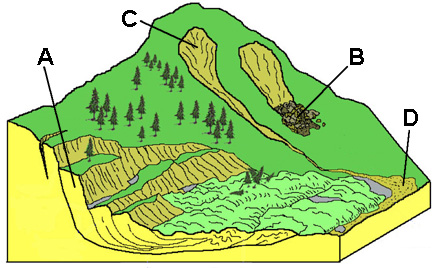 |
Introduction to Geology |
| Quiz 8 - Weathering & Erosion |
| 1. Which of these best describe weathering? a. the transfer of rock material downslope by gravity b. the mechanical and chemical disintegration of rock on or near the surface c. the alteration of igneous rocks into sand and clay minerals d. the removal of material by flowing water, air, or ice 2. Frost wedging, exfoliation, and thermal expansion are examples of: a. erosion. b. mechanical weathering. c. chemical weathering. d. mass wasting. 3. What is the most important agent of chemical weathering on Earth? a. oxygen b. salt c. carbon dioxide d. carbonic acid e. water 4. Which of the following is NOT a process of chemical weathering. a. hydrolysis b. oxidation c. carbonation d. erosional grinding 5. Which of these common minerals is most resistant to weathering on the Earth's surface? a. quartz b. olivine c. biotite mica d. potassium feldspar e. calcite 6. When a granite is weathered and eroded, what eventually happens to most of the feldspar? a. it is broken down to form clay minerals b. it is broken down to become carbonate minerals c. it changes to biotite d. it remain virtually unchanged, becoming gravel, sand, and silt e. it dissolves and becomes part of seawater. 7. Rounded boulders scattered on a landscape that have not been moved far from their place of may original form by the process of: a. spheroidal weathering. b. tafoni. c. saprolite. d. erosion. 8. What is the layer of rock and mineral fragments produced by weathering located between the bedrock and the surface in most places? a. humus b. soil c. alluvium d. regolith e. zone of leaching 9. Loose and incoherent surfacial deposits usually found on or along the base of a slope and brought their chiefly by gravity: a. colluvium b. alluvium c. laterite d. chalky soil e. loam 10. Loose (unconsolidated) sediments moved and deposited by flowing water is called: a. colluvium b. alluvium c. laterite d. chalky soil e. loam 11. Regarding the size of clastic sediment particles, which selection below arranges particles from LARGEST to SMALLEST? a. cobbles - boulders - gravel - sand - silt - clays b. cobbles - boulders - gravel - silt - sand - clays c. boulders - cobbles - gravel - silt - sand - clays d. boulders - cobbles - gravel - sand - silt - clays 12. What is perhaps the most important factor in soil formation and soil character? a. climate b. microorganisms living in or on the soil c. erosion rates d. duration of exposure to air 13. Which of these is a component of soil? a. disintegrated and decomposed rock b. decayed organic matter c. air d. water e. all of the above 14. Which horizon in a soil profile is the zone of leaching of soluble mineral components? a. O horizon b. A horizon c. B horizon d. C horizon e. bedrock The graphic below corresponds to questions 15 and 16.  15. What forces and processes are responsible for the features illustrated on the diagram? a. weathering and erosion b. mass wasting c. landsliding d. gravity e. all of the above 16. What kind of feature is illustrated in by letter A in the illustration above? a. slump b. rock fall c. talus slope d. debris flow 17. The angle of repose is the steepest angle of descent or dip of the slope relative to the horizontal plane when material on the slope face is on the verge of sliding. A sloping mass or cone-shaped deposit of rock fragments (often loose or slightly compacted pile resting at the angle of repose) located at the foot of a cliff is called: a. topple. b. talus. c. a toe. d. a rock fall. 18. Heat of a volcanic eruption can suddenly melt glacial ice contributing massive amounts of water to a pyroclastic flow producing: a. a nuée ardente. b. an avalanche. c. a lahar. d. a slump. Clues where to find answers. |
12/7/2017